CATASTROPHE INDONESIA
Indonesia: Over 150 killed as earthquake hits island of Java
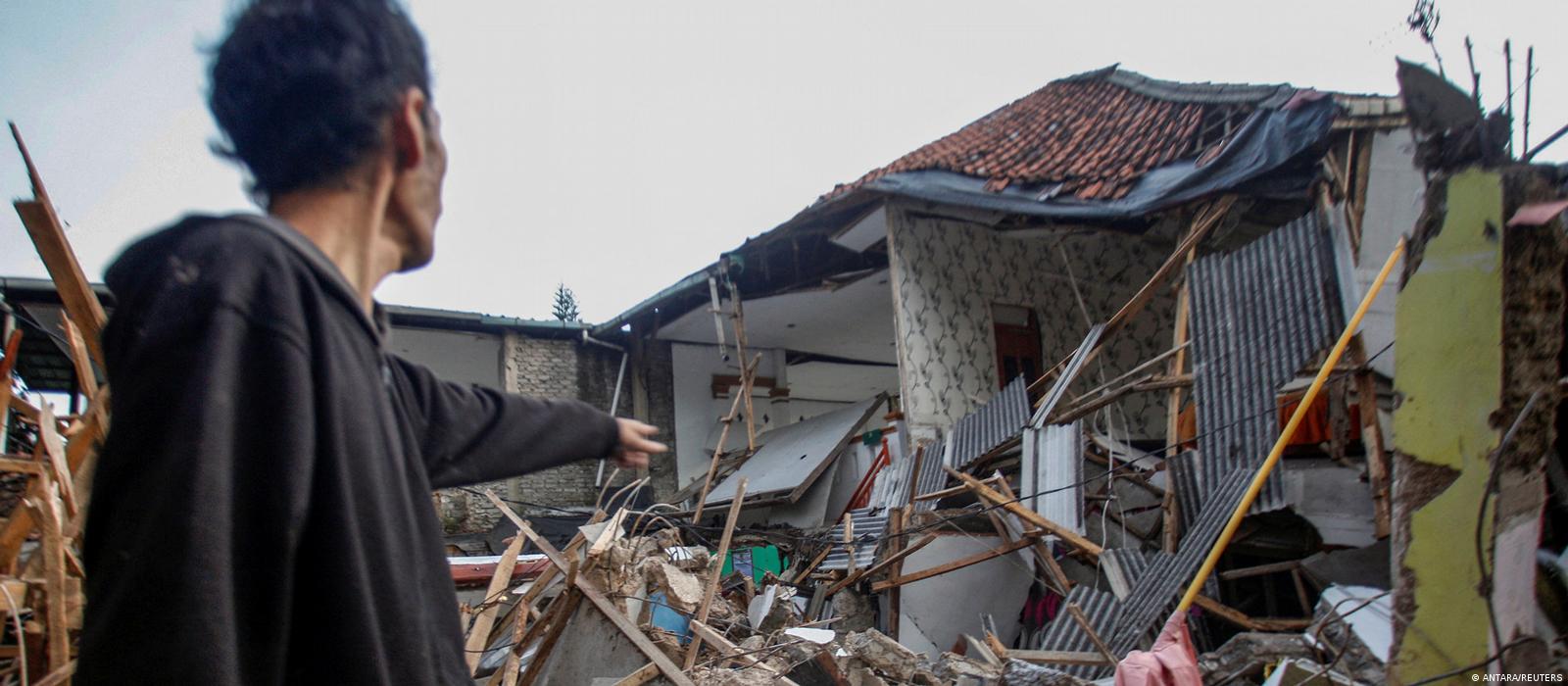
Officials reported scores of deaths after an earthquake struck the highly populated island of Java, with tremors also felt in Jakarta. The victims include children who were killed when a school collapsed.
https://p.dw.com/p/4Jol4
At least 162 people were killed after an earthquake hit the Indonesian island of Java on Monday, with the tremors being felt in the capital Jakarta, the island's governor said.
The magnitude 5.6 quake — according to the US Geological Survey — struck in the afternoon in the Cianjur region of West Java province, some 75 kilometers (47 miles) south of the capital.
What we know so far
West Java Governor Ridwan Kamil told a press conference on Monday night, "I regret to inform that 162 are dead."
At least 326 people were injured in the quake, the governor added, with many sustaining fractures "from being crushed in the ruins."
Kamil said that "the majority of those who died were children." Many of the victims were students in public schools who finished classes for the day and were attending extra lessons at Islamic schools.
Cianjur, a town with roughly 175,000 people, is located in a mountainous district of the same name with over 2.5 million inhabitants. The town is known for having a large number of mosques and Islamic boarding schools.
The number of dead and injured was still being assessed and authorities said both could rise. Earlier estimates put the number of injured at over 700.
Indonesia's national disaster mitigation agency, BNPB, said that at least 25 people are believed to be trapped under rubble.
Initial counts estimate 2,000 houses were damaged, with 13,000 people taken to evacuation centers.
Power outages have also hampered rescue efforts, with at least one hospital left without electricity — making it
The force damaged several buildings including a hospital and an Islamic boarding school.
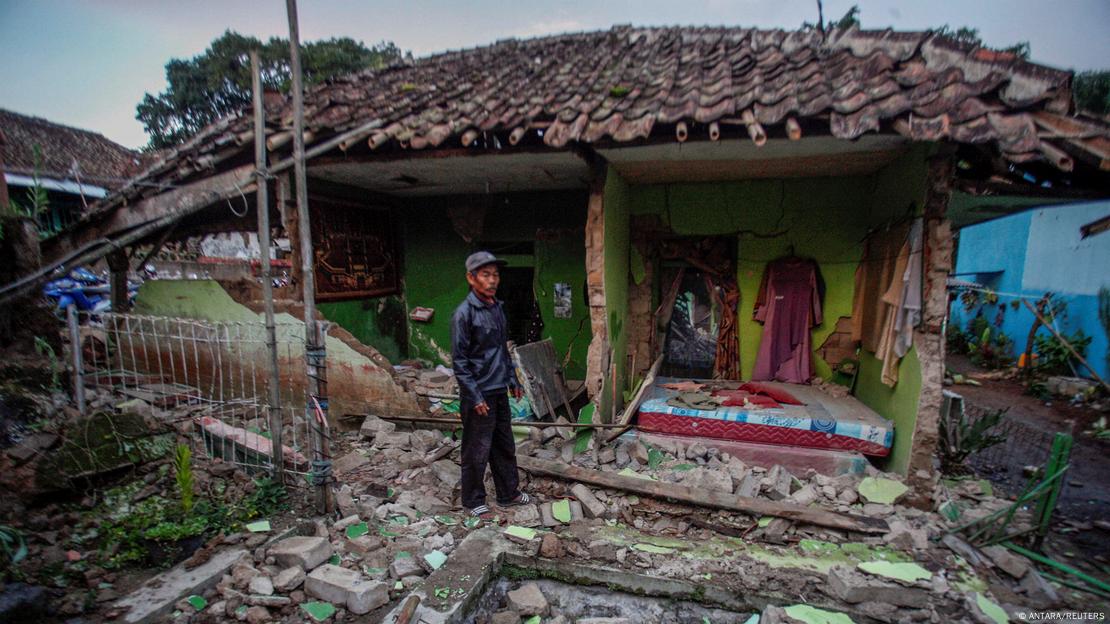

Officials reported scores of deaths after an earthquake struck the highly populated island of Java, with tremors also felt in Jakarta. The victims include children who were killed when a school collapsed.
https://p.dw.com/p/4Jol4
At least 162 people were killed after an earthquake hit the Indonesian island of Java on Monday, with the tremors being felt in the capital Jakarta, the island's governor said.
The magnitude 5.6 quake — according to the US Geological Survey — struck in the afternoon in the Cianjur region of West Java province, some 75 kilometers (47 miles) south of the capital.
What we know so far
West Java Governor Ridwan Kamil told a press conference on Monday night, "I regret to inform that 162 are dead."
At least 326 people were injured in the quake, the governor added, with many sustaining fractures "from being crushed in the ruins."
Kamil said that "the majority of those who died were children." Many of the victims were students in public schools who finished classes for the day and were attending extra lessons at Islamic schools.
Cianjur, a town with roughly 175,000 people, is located in a mountainous district of the same name with over 2.5 million inhabitants. The town is known for having a large number of mosques and Islamic boarding schools.
The number of dead and injured was still being assessed and authorities said both could rise. Earlier estimates put the number of injured at over 700.
Indonesia's national disaster mitigation agency, BNPB, said that at least 25 people are believed to be trapped under rubble.
Initial counts estimate 2,000 houses were damaged, with 13,000 people taken to evacuation centers.
Power outages have also hampered rescue efforts, with at least one hospital left without electricity — making it
The force damaged several buildings including a hospital and an Islamic boarding school.

A man stands in front of the rubble of his home in Cianjur, West Java province after a shallow earthquake rocked the region
ANTARA/REUTERS
Footage broadcast on Indonesian TV showed a number of buildings in Cianjur that had been almost totally destroyed. Images showed cracked roads and houses badly damaged in Cianjur's Cugenang area.
Agus Azhari told news agency AFP he was with his elderly mother when strong tremors destroyed their living room within seconds. Parts of the walls and roof fell-in around them.
"I pulled my mother's hand, and we ran outside," he said. "I heard people screaming for help from all around me," the 19-year-old told AFP.
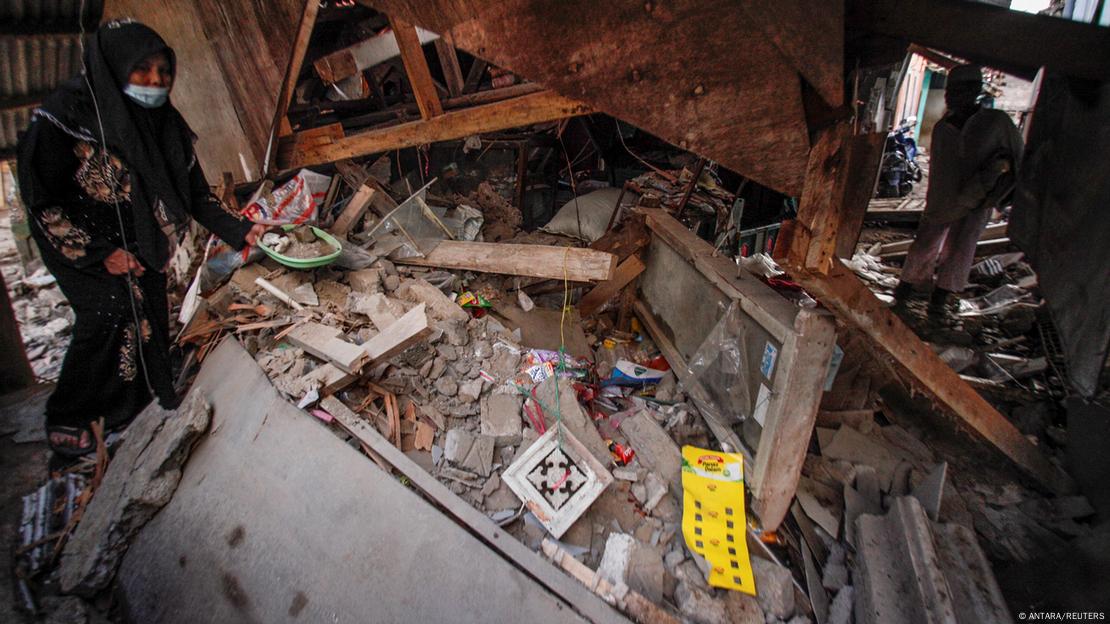
Footage broadcast on Indonesian TV showed a number of buildings in Cianjur that had been almost totally destroyed. Images showed cracked roads and houses badly damaged in Cianjur's Cugenang area.
Agus Azhari told news agency AFP he was with his elderly mother when strong tremors destroyed their living room within seconds. Parts of the walls and roof fell-in around them.
"I pulled my mother's hand, and we ran outside," he said. "I heard people screaming for help from all around me," the 19-year-old told AFP.

A local woman attempts to collect her belongings from her house in Cianjur after it was destroyed in Monday's earthquake
Image: ANTARA/REUTERS
In Jakarta, some people evacuated offices as buildings started to shake.
"The quake felt so strong. My colleagues and I decided to get out of our office on the ninth floor using the emergency stairs," a worker in South Jakarta told the Associated Press news agency.
Earthquake-prone 'Ring of Fire'
Indonesia is situated on the so-called "Ring of Fire" — a region around the rim of the Pacific Basin that is particularly vulnerable to earthquakes and volcanic eruptions.
The country of 270 million is frequently struck by quakes, one of the most recent, in February of this year, killed at least 25 people and injured another 460 in West Sumatra province.
rs, ab/dj (Reuters, AP, dpa, AFP)
In Jakarta, some people evacuated offices as buildings started to shake.
"The quake felt so strong. My colleagues and I decided to get out of our office on the ninth floor using the emergency stairs," a worker in South Jakarta told the Associated Press news agency.
Earthquake-prone 'Ring of Fire'
Indonesia is situated on the so-called "Ring of Fire" — a region around the rim of the Pacific Basin that is particularly vulnerable to earthquakes and volcanic eruptions.
The country of 270 million is frequently struck by quakes, one of the most recent, in February of this year, killed at least 25 people and injured another 460 in West Sumatra province.
rs, ab/dj (Reuters, AP, dpa, AFP)
'I Was Crushed': Fear And Panic Grip Indonesian Town Battered By Quake
By Dessy Sagita with Gemma Cahya in Jakarta
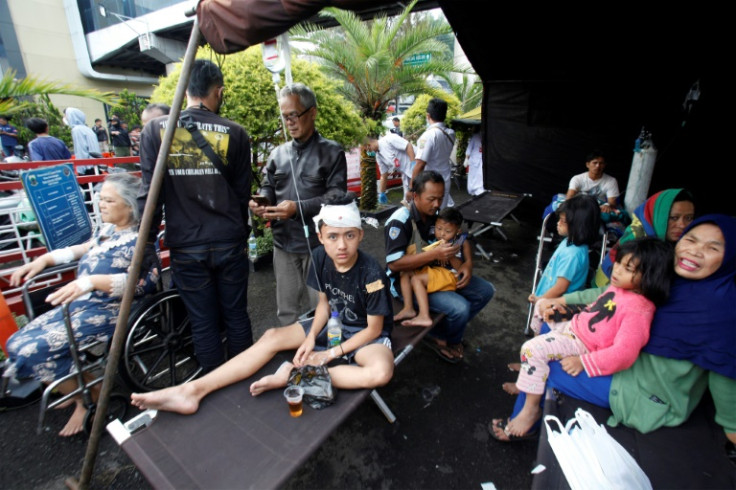
By Dessy Sagita with Gemma Cahya in Jakarta
11/21/22
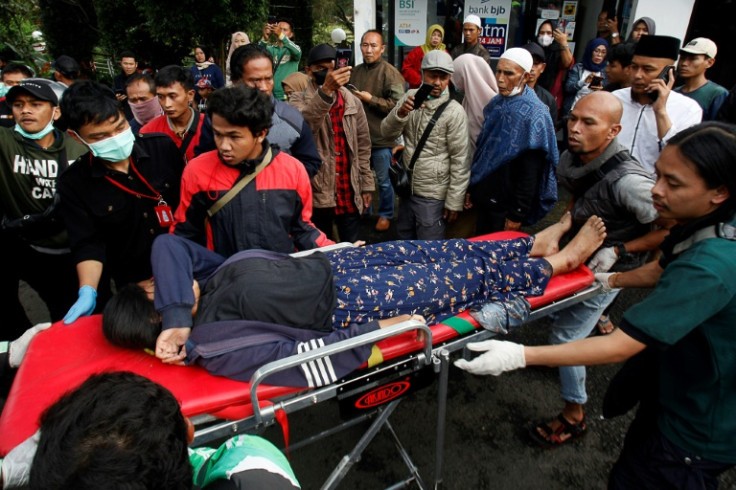

People evacuate a wounded woman on a stretcher following a landslide triggered by earthquake in Cianjur
Surrounded by chaos, panicked residents still filled the streets and hospitals of a West Javan town on Monday hours after a quake killed at least 62 people and injured hundreds more.
Agus Azhari, 19, was with his mother in their family home when the living room was destroyed within seconds by the quake that was centred on West Java's Cianjur, the worst-hit town.
Parts of the walls and roof fell to the floor, along with cupboards and other debris that hit his legs and hands.
"I couldn't see anything. The dust from the debris blocked my sight for a while," Azhari told AFP. He said he had never experienced an earthquake like it before.
The Indonesian teen shared a video in which his 56-year-old mother screams, "Lord have mercy! My house!" as their home shook.
"I pulled my mother's hand and we ran outside," he said. "I heard people screaming for help from all around me."
The shallow tremor, with a magnitude of 5.6, brought down the roofs and walls of homes built on the town's hilly landscape. Many were made more vulnerable by the use of wood, mud and concrete in their construction.
Emergency workers raced to treat victims in any outdoor space possible, with the town's three hospitals overwhelmed and not enough rooms to cope with an injury toll of 700.
At least 25 people were still trapped in the rubble, authorities said.
Residents rushed lifeless bodies to Cianjur's Sayang hospital in pickup trucks and on motorbikes. Power outages meant doctors were unable to operate immediately.
Some of the injured sat on stretchers or blankets with their heads and limbs bandaged. Elderly women sat in wheelchairs waiting to be treated as crowds of worried bystanders looked on.
At another hospital, Cimacan, victims arrived covered in blood while parents looked for missing children.
Several injured elderly women were taken on stretchers into makeshift green tents erected outside the hospital.
People ran to resuscitate victims in the immediate aftermath of the quake, while others fled their homes for safety.
Dozens of aftershocks shook the town for minutes that, for rattled locals, seemed like hours.
The province's governor said some of the injured needed their heads and feet stitched back together from wounds sustained by the debris falling around them.
Landslides around the town buried bodies, and bulldozers were mobilised to reopen roads.
A woman and a baby were pulled alive from the rubble, while others lost their lives nearby.
Oman, a 55-year-old who, like most Indonesians goes by one name, was making fried rice in a village near Cianjur when his house started to sway.
"All of a sudden I was crushed beneath it. I could do nothing in the rubble. My wife was outside at the time," he said.
His feet, legs and hands were squeezed in the ruins but his son arrived to pull him free, emerging with only a broken leg and a bloodied body.
"I did not know where to go but at least I am alive," Oman said.
The search for survivors was set to last well into the night as survivors reckoned with the carnage of lost homes and relatives.
"My mother looked at her house and she cried," Azhari said.
Surrounded by chaos, panicked residents still filled the streets and hospitals of a West Javan town on Monday hours after a quake killed at least 62 people and injured hundreds more.
Agus Azhari, 19, was with his mother in their family home when the living room was destroyed within seconds by the quake that was centred on West Java's Cianjur, the worst-hit town.
Parts of the walls and roof fell to the floor, along with cupboards and other debris that hit his legs and hands.
"I couldn't see anything. The dust from the debris blocked my sight for a while," Azhari told AFP. He said he had never experienced an earthquake like it before.
The Indonesian teen shared a video in which his 56-year-old mother screams, "Lord have mercy! My house!" as their home shook.
"I pulled my mother's hand and we ran outside," he said. "I heard people screaming for help from all around me."
The shallow tremor, with a magnitude of 5.6, brought down the roofs and walls of homes built on the town's hilly landscape. Many were made more vulnerable by the use of wood, mud and concrete in their construction.
Emergency workers raced to treat victims in any outdoor space possible, with the town's three hospitals overwhelmed and not enough rooms to cope with an injury toll of 700.
At least 25 people were still trapped in the rubble, authorities said.
Residents rushed lifeless bodies to Cianjur's Sayang hospital in pickup trucks and on motorbikes. Power outages meant doctors were unable to operate immediately.
Some of the injured sat on stretchers or blankets with their heads and limbs bandaged. Elderly women sat in wheelchairs waiting to be treated as crowds of worried bystanders looked on.
At another hospital, Cimacan, victims arrived covered in blood while parents looked for missing children.
Several injured elderly women were taken on stretchers into makeshift green tents erected outside the hospital.
People ran to resuscitate victims in the immediate aftermath of the quake, while others fled their homes for safety.
Dozens of aftershocks shook the town for minutes that, for rattled locals, seemed like hours.
The province's governor said some of the injured needed their heads and feet stitched back together from wounds sustained by the debris falling around them.
Landslides around the town buried bodies, and bulldozers were mobilised to reopen roads.
A woman and a baby were pulled alive from the rubble, while others lost their lives nearby.
Oman, a 55-year-old who, like most Indonesians goes by one name, was making fried rice in a village near Cianjur when his house started to sway.
"All of a sudden I was crushed beneath it. I could do nothing in the rubble. My wife was outside at the time," he said.
His feet, legs and hands were squeezed in the ruins but his son arrived to pull him free, emerging with only a broken leg and a bloodied body.
"I did not know where to go but at least I am alive," Oman said.
The search for survivors was set to last well into the night as survivors reckoned with the carnage of lost homes and relatives.
"My mother looked at her house and she cried," Azhari said.

Wounded people rest under a tent displayed outside a hospital following an earthquake in Cianjur


People handle a dead body following an earthquake, at a hospital in Cimacan
© Copyright AFP 2022. All rights reserved.
© Copyright AFP 2022. All rights reserved.
A 5.6-magnitude earthquake killed at least 36 people and injured about 700 others in Cianjur town, Indonesia's West Java province on November 21 afternoon, according to the town’s authorities.
A house damaged in the earthquake in Cianjur town of Indonesia's West Java province on November 21 (Photo: Xinhua/VNA)Hanoi (VNA) - A 5.6-magnitude earthquake killed at least 36 people and injured about 700 others in Cianjur town, Indonesia's West Java province on November 21 afternoon, according to the town’s authorities.
Herman Suherman, a government official in Cianjur, said that some residents were trapped in the rubble of collapsed buildings. News channel Metro TV showed what appeared to be hundreds of victims being treated in a hospital parking lot.
According to the National Disaster Mitigation Agency (BNPB), the quake’s epicentre was at a depth of 10 km (6.2 miles). There was no potential for a tsunami.
Indonesia is prone to earthquakes as it sits in a vulnerable area called the Pacific Ring of Fire./.
Herman Suherman, a government official in Cianjur, said that some residents were trapped in the rubble of collapsed buildings. News channel Metro TV showed what appeared to be hundreds of victims being treated in a hospital parking lot.
According to the National Disaster Mitigation Agency (BNPB), the quake’s epicentre was at a depth of 10 km (6.2 miles). There was no potential for a tsunami.
Indonesia is prone to earthquakes as it sits in a vulnerable area called the Pacific Ring of Fire./.
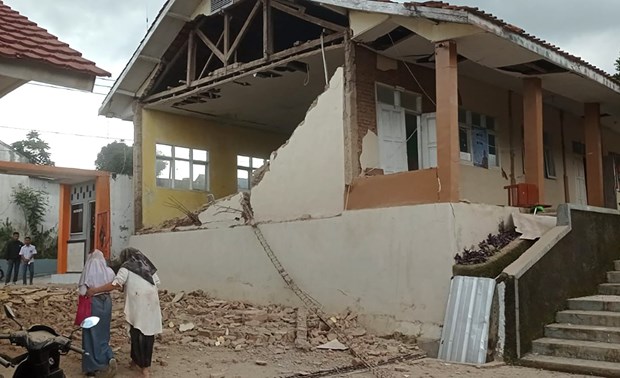
No comments:
Post a Comment